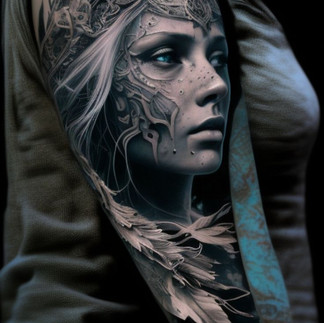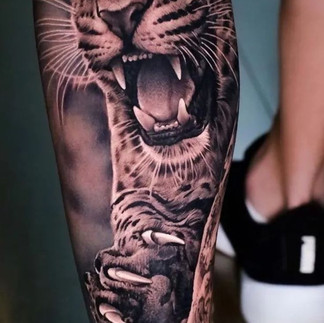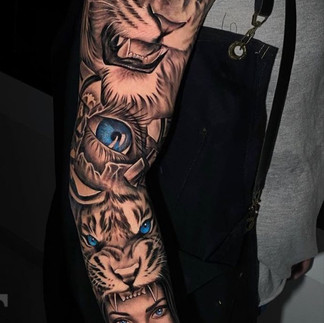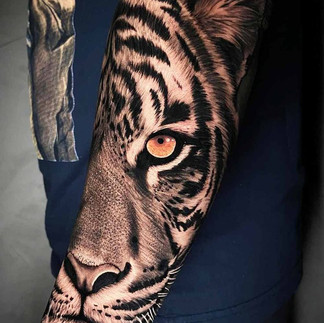Realistic Tattoo: Ideas, Style and Design
- Leonardo Pereira

- Aug 4
- 14 min read
Updated: Nov 10
In the dynamic and ever-evolving world of body art, realistic tattoos stand as a testament to the incredible skill and artistry achievable on human skin. These intricate designs aim to recreate photographic-quality images on the human body, requiring exceptional skill, precision, and attention to detail from the artist.
Unlike traditional tattoo styles that rely on bold outlines and simplified forms, realistic tattoos delve into the nuances of light, shadow, and texture to bring subjects to life with astonishing accuracy.
This style has captivated enthusiasts and artists alike, pushing the boundaries of what is possible with ink and needle.
The allure of realistic tattoos lies in their ability to transform skin into a canvas for breathtakingly lifelike portraits, landscapes, animals, or objects. They are chosen by individuals who seek to immortalize a memory, honor a loved one, or simply appreciate the profound beauty of art that mirrors reality.
Mastering the art of realism in tattooing is a journey that combines artistic talent with technical prowess, demanding an intimate understanding of anatomy, perspective, and color theory.
This guide will delve into the fascinating world of realistic tattoos, exploring the artistry behind them, the techniques involved, the process of getting one, and what the future holds for this captivating form of body art.
Table of Contents
The Artistry Behind Realistic Tattoos
The creation of realistic tattoos is a profound display of artistic talent, demanding a mastery that extends beyond mere technical application. It's about transforming a flat image into a three-dimensional illusion on a living, breathing canvas, a feat that requires an exceptional understanding of visual principles and a meticulous approach to every detail.
At the heart of realistic tattoo artistry lies the mastery of shading and detail work. Artists specializing in realism must have an intimate understanding of light and shadow, as well as the ability to translate these elements onto the skin. This involves careful observation of the reference image and a precise execution to create the illusion of depth and form.
Understanding Light Source: Identifying where light originates and how it interacts with the subject to create highlights, mid-tones, and deep shadows.
Creating Depth: Using varying degrees of darkness and contrast to give the illusion of depth and form, making the image appear to recede or project from the skin.
Texture Replication: Replicating the texture of different materials, whether it's the softness of fur, the roughness of stone, the smoothness of skin, or the glint in an eye, with remarkable accuracy.
The level of detail in realistic tattoos is often astonishing, with artists able to capture everything from the softness of fur to the glint in an eye with remarkable accuracy. This meticulous attention to minute features is what truly brings the image to life, creating a captivating illusion of reality and cementing the artistry involved in every piece.
Techniques Used in Realistic Tattooing
The evolution of realistic tattooing has been driven by the development of sophisticated techniques that allow artists to achieve unparalleled levels of depth, texture, and lifelike qualities. These methods go beyond basic tattooing, requiring specialized knowledge and a delicate hand to manipulate ink and needles for stunning results.
The techniques used in realistic tattooing have evolved significantly over the years, incorporating advanced methods that allow for stunning depth, texture, and lifelike qualities. This involves using a variety of needle configurations and techniques to create subtle gradients, fine lines, and intricate textures that bring the image to life on the skin, mimicking the nuances of a photograph or real-world subject.
Needle Configurations: Artists utilize a wide array of needle groupings, from single needles for ultra-fine details to larger magnum needles for smooth shading and color packing, selecting the right tool for each specific effect.
Layering and Blending: Building up tones and colors in multiple, thin layers to achieve seamless transitions and avoid harsh lines. This often involves a soft, circular motion or a pendulum-like technique to ensure smooth gradients.
Whip Shading and Stippling: While less common for large areas, these techniques can be used for specific textures or to create a sense of grit and realism in certain elements, adding character where needed.
Negative Space: Strategically using the client's skin tone as part of the design, particularly in black and gray realism, to create highlights and define forms without using white ink, making the skin itself an element of the art.
Understanding Skin as a Medium: Recognizing how ink settles in the skin and how the skin's natural texture and undertones will affect the final appearance of the tattoo. This crucial understanding allows artists to adapt their technique for optimal results.
These advanced techniques, combined with an artist's innate talent, are what allow realistic tattoos to achieve their breathtaking, true-to-life appearance, making them a marvel of modern tattoo artistry.
The Role of Color in Realistic Tattoos
Color plays a crucial role in realistic tattoos, offering artists the choice between vibrant color realism and the classic appeal of black and gray work. Each approach presents its own set of challenges and rewards, influencing the overall impact, aesthetic, and longevity of the tattoo. The decision between color and black and gray is fundamental, as it dictates the palette and the specific techniques employed to achieve lifelike representation.
Color Realism
Color realistic tattoos present unique challenges, requiring a deep understanding of color theory and the ability to mix and layer inks to achieve true-to-life hues. This approach aims to replicate the full spectrum of colors found in the reference image, creating a vibrant and dynamic piece that bursts with life and detail.
Achieving photographic accuracy in color demands meticulous attention to every shade and tone.
Color Theory Mastery: Artists must understand how colors interact, how to create depth with warm and cool tones, and how to achieve accurate skin tones or natural gradients, ensuring a harmonious and lifelike palette.
Layering and Saturation: Building up color in multiple, thin layers to ensure proper saturation and vibrancy, preventing the tattoo from looking flat or muddy. This technique creates richness and dimension.
Longevity Considerations: Certain colors may fade differently over time due to sun exposure or natural skin processes, requiring careful planning and potentially future touch-ups to maintain vibrancy and ensure the artwork ages gracefully.
Black and Gray Realism
Black and gray realistic tattoos, while seemingly simpler in their limited palette, demand an equally profound understanding of light, shadow, and contrast.
Artists must manipulate various shades of black ink (diluted to different values) to create depth, texture, and the illusion of form, relying heavily on nuanced transitions to bring the image to life. This style often highlights the stark beauty of contrast and subtlety.
Value Scale: Mastering the full range of values from pure black to the lightest grays and whites to create dimension and contrast is paramount for achieving depth and realism without color.
Texture and Detail: Using different needle groupings and techniques to replicate textures like hair, skin, fabric, or metal using only shades of gray requires immense skill and precision, bringing tactile quality to the monochromatic image.
Timeless Appeal: Black and gray tattoos often have a classic, timeless aesthetic that can age gracefully. Their monochromatic nature allows them to blend seamlessly with various styles and remain striking over the years, making them a popular choice for many clients.
The choice between color and black and gray realism often depends on the subject matter, the client's preference, and the artist's specialization. Both styles, when executed by a skilled artist, can result in stunningly lifelike and impactful realistic tattoos, showcasing the immense talent involved in this art form.
The Process of Getting a Realistic Tattoo
Embarking on the journey of getting a realistic tattoo is a collaborative process that begins long before the needle touches the skin.
It involves careful planning, open communication, and a deep understanding between the client and the artist to ensure the final piece truly captures the desired vision and meets expectations. This meticulous approach is what sets realistic tattooing apart.
The initial consultation and design phase is crucial in ensuring that the final tattoo meets your expectations and showcases the artist's skills to their fullest potential. During this phase, you'll discuss your ideas in detail with the artist, providing reference images and explaining the personal significance of the tattoo. This sets the foundation for a successful and meaningful piece of body art.
Initial Consultation: This is where you share your vision, ideas, and any reference images. Be as specific as possible about the subject, mood, and any personal meaning behind the tattoo.
Artist's Interpretation: A skilled realistic tattoo artist will take the time to understand not just the visual aspects you're looking for, but also the emotion and meaning behind the piece. They will offer their professional opinion on feasibility, placement, and size, ensuring the design is optimized for the skin.
Design Creation: Based on your discussions, the artist will begin creating a custom design. This might involve digital mock-ups, hand-drawn sketches, or a combination of both. This phase can take time, as realism demands meticulous planning and precise execution.
Approval and Stenciling: Once the design is finalized and approved by you, the artist will prepare the stencil. This is a critical step to ensure accurate placement and proportion on your body, as even slight misalignments can impact the realism.
The Tattoo Session: The actual tattooing process for realism often involves multiple, long sessions, especially for larger pieces. Artists work meticulously, layering ink to build depth, detail, and texture, ensuring every aspect of the design is perfectly rendered.
Pain Management: Be prepared for varying levels of discomfort, especially during longer sessions or on sensitive areas. Communicate openly with your artist about your pain tolerance, and they can suggest breaks or techniques to manage discomfort.
Aftercare for Your Realistic Tattoo

Proper aftercare is paramount for any tattoo, but it's especially critical for realistic tattoos due to their intricate details and subtle shading.
Diligent care ensures optimal healing, preserves the design's sharpness, and maintains its vibrancy for years to come, protecting your significant investment in this demanding art form.
The longevity of a realistic piece hinges heavily on conscientious aftercare.
Immediate Aftercare Steps
The first few days after getting your realistic tattoo are crucial for setting the stage for optimal healing.
Following your artist's precise instructions during this period is non-negotiable, as proper initial care prevents most complications and lays the groundwork for the tattoo's long-term appearance.
Consistent and careful adherence to these steps will significantly impact the final result.
Initial Bandage: Your tattoo artist will apply a protective bandage immediately after the session. This might be traditional plastic wrap or a specialized healing film like Saniderm Tattoo Bandages. This bandage protects the fresh wound from bacteria and foreign particles. Follow their specific instructions on how long to keep it on before removal, as timings vary for different bandage types.
Gentle Cleaning: Once the bandage is removed (as per artist's instructions), gently wash your realistic tattoo with lukewarm water and a small amount of gentle, fragrance-free hand soap. Use your fingertips to gently cleanse the area, removing any excess ink, plasma, or ointment. Pat it dry with a clean paper towel; avoid rubbing or using a cloth towel which can harbor bacteria and cause irritation. Repeat this cleaning process 2-3 times a day.
Moisturizing: After each cleaning, once the tattoo is completely dry, apply a very thin layer of a high-quality tattoo balm or unscented, gentle moisturizer. Products like Hustle Butter Deluxe or Aquaphor Healing Skin Ointment are excellent choices known for aiding healing without clogging pores. The key is "thin layer" – do not over-moisturize, as this can suffocate the skin and impede healing, potentially leading to breakouts.
Long-Term Care and Protection
Beyond the initial healing phase, consistent long-term care is vital to preserve the clarity and vibrancy of your realistic tattoo.
These habits will protect your investment for decades, ensuring its beauty endures and the intricate details remain sharp over time.
Continuous protection is key to maintaining the high quality of realistic ink.
Sun Protection: This is perhaps the most crucial step for the longevity of realistic tattoos, as UV rays are the primary culprits behind ink fading and blurring. Even intricate details can suffer significantly. Always apply a broad-spectrum sunscreen like Mad Rabbit SPF 30 to your tattoo whenever it's exposed to sunlight, even on cloudy days. Physical barriers like clothing are also effective ways to protect your ink.
Avoid Soaking: During the initial healing period (typically the first 2-4 weeks), avoid submerging your tattoo in baths, swimming pools, hot tubs, or natural bodies of water. This can introduce bacteria and lead to infection, severely compromising the healing process. Quick showers are perfectly fine.
Avoid Friction: Be mindful of clothing or jewelry rubbing against your realistic tattoo, especially during the initial healing phase. Constant friction can irritate the healing skin and lead to ink loss or blurring of fine lines.
Hydration: Keep your skin well-hydrated from the inside out by drinking plenty of water. Externally, continue using a good daily moisturizer like Eucerin Advanced Repair Lotion on your tattoo even after it's fully healed. Healthy, hydrated skin displays tattoo ink more vibrantly and stays supple.
The Future of Realistic Tattoos
The world of realistic tattoos is constantly evolving, driven by technological advancements and the boundless creativity of artists.
The future promises even more breathtaking possibilities, pushing the boundaries of what can be achieved on skin and elevating the art form to new heights of lifelike representation.
One of the most promising developments is the refinement of tattoo machines, with new models offering unprecedented precision and control.
These advanced machines allow artists to create even finer details and smoother gradients, resulting in tattoos that achieve new levels of realism and durability.
This technological leap empowers artists to execute their visions with greater accuracy.
Advanced Machines: Next-generation tattoo machines provide artists with greater control over needle depth, speed, and consistency, enabling more intricate and delicate work, pushing the limits of detail.
Specialized Needles: Innovations in needle design allow for even finer lines, softer shading, and more precise color packing, contributing to hyper-realistic effects and smoother transitions in the ink.
Digital technology is also transforming the way realistic tattoos are designed and planned. Augmented reality (AR) applications are being developed that allow clients to see how a tattoo will look on their body before any ink is applied, revolutionizing the consultation and design approval process. This pre-visualization eliminates guesswork and enhances client confidence.
Augmented Reality (AR): AR apps enable clients to visualize the tattoo on their skin in real-time, experimenting with size, placement, and design variations before committing, offering an immersive preview.
3D Modeling and Rendering: Artists can use 3D software to create highly detailed models of their designs, allowing for precise planning of light, shadow, and perspective. This ensures optimal rendering on the complex curves of the human body.
AI-Assisted Design: While still in early stages, AI tools could potentially assist artists in generating reference images or exploring design concepts, streamlining the creative process and offering new possibilities for inspiration and ideation.
These advancements, combined with the continuous dedication of realistic tattoo artists to hone their craft, promise a future where body art reaches new heights of lifelike beauty and artistic expression, making the impossible seem possible on skin.
Frequently Asked Questions (FAQ) About Realistic Tattoos
What makes a tattoo "realistic"?
A realistic tattoo aims to replicate a photographic image or a real-life subject with extreme accuracy on the skin.
This involves meticulous attention to detail, mastery of light and shadow, precise color matching (for color realism), and the ability to create the illusion of depth and texture, making the tattoo appear three-dimensional and lifelike.
Are realistic tattoos more painful than other styles?
The pain level of a realistic tattoo is similar to other styles, primarily depending on placement and individual pain tolerance.
However, realistic tattoos often involve longer sessions and more intricate detail work, which can lead to increased discomfort over time.
The artist's technique (e.g., a lighter hand) can also influence the pain experienced.
How long does a realistic tattoo take to complete?
Realistic tattoos typically require significant time due to their complexity and detail. A small, simple realistic piece might take a few hours, but larger, highly detailed portraits or full sleeves can require multiple sessions, each lasting several hours, potentially spanning weeks or even months to complete.
Do realistic tattoos age well?
When done by a highly skilled artist using proper techniques and high-quality inks, and with diligent aftercare, realistic tattoos can age very well. However, fine details and subtle shading may soften over time.
Consistent sun protection and regular moisturizing are crucial for maintaining their clarity and vibrancy.
Occasional touch-ups may be needed to refresh the design.
How do I choose the right artist for a realistic tattoo?
Choosing the right artist is paramount for a realistic tattoo.
Look for artists whose portfolios heavily feature realistic work, especially in the specific subject matter (e.g., portraits, animals) and style (color or black and gray) you desire. Pay attention to healed work, detail, and shading.
Schedule a consultation to discuss your vision and assess their communication and professionalism.
Is color realism harder to maintain than black and gray realism?
Color realism can sometimes be more challenging to maintain than black and gray realism. Vibrant colors, especially lighter hues, can be more susceptible to fading from sun exposure.
Black and gray tattoos, relying on a more limited palette, often maintain their contrast and clarity well over time.
Regardless of color, diligent sun protection and proper aftercare are essential for both styles.
Conclusion: The Enduring Appeal of Realism
Realistic tattoos represent the pinnacle of technical skill and artistic vision in the world of body art. They are a powerful medium for self-expression, allowing individuals to carry breathtakingly lifelike images on their skin, imbued with personal meaning and profound beauty.
From the meticulous mastery of light and shadow to the intricate replication of textures, every aspect of a realistic tattoo demands an artist's unwavering dedication and expertise.
The journey of acquiring a realistic tattoo is a collaborative one, a testament to the bond between client and artist. It involves careful planning, open communication, and a shared commitment to bringing a vision to life with unparalleled accuracy.
The choice between vibrant color realism and the timeless elegance of black and gray work further personalizes this art form, each offering a unique way to capture the essence of reality.
As technology continues to advance, the future of realistic tattoos promises even more astonishing possibilities, with refined machines and digital tools empowering artists to push creative boundaries further.
However, the core of this art form will always remain the human element: the artist's talent, the client's story, and the enduring appeal of transforming skin into a canvas that mirrors the world around us.
Ultimately, a realistic tattoo is more than just ink; it's a permanent masterpiece, a conversation starter, and a profound reflection of the wearer's appreciation for art, memory, and the beauty of life itself.
By understanding the artistry, techniques, and care involved, you can embark on your own journey to master the art of realism on your skin, creating a piece that will be cherished for a lifetime.
For a deeper dive into the world of tattoos, consider the Perfect Tattoo Guide 2.0.
See More: ⤵
Nipple Tattoos: A Comprehensive Guide to Areola Reconstruction and Decorative Designs
Hip Tattoos: The Ultimate Guide to Choosing and Caring for Your Sexy Hip Ink
Divergent Tattoos: A Comprehensive Guide to Choosing, Placing, and Caring for Your Ink
Forearm Tattoos for Women: Styles, Inspiration, and Considerations
Sleeve Tattoos for Men: The Ultimate Guide to Designing and Rocking Your Ink
Best Friend Tattoos: Celebrating the Unbreakable Bond of Friendship
Wave Tattoo: Unleashing the Power and Beauty of the Ocean on Your Skin
Wrist Tattoos: Meaningful Designs and Ideas for Your Next Ink
Halloween Tattoos: Spooky and Creative Ideas for Ink Enthusiasts
Japanese Tattoo: Exploring the Rich History and Symbolism of Irezumi
Infinity Tattoo Ideas: Endless Inspiration for Your Next Ink
Cat Tattoos: Meanings, Designs, and Ideas for Feline-Inspired Ink
Feather Tattoo: Meanings, Designs, and Ideas for Your Next Ink
Lotus Flower Tattoo: Meanings, Designs, and Ideas for Your Next Ink
Polynesian Tattoo: Unraveling the Meanings and Traditions Behind the Ancient Art
Birth Flower Tattoos: Celebrating Your Birthday with Floral Ink
Forearm Tattoos for Women: Embracing Femininity and Self-Expression
Head Tattoos for Guys: Bold Designs and Crucial Considerations
Forearm Tattoos: Unleashing Your Personal Style on Skin Canvas
Arm Tattoos: Your Ultimate Guide to Inked Sleeves and Beyond
Phoenix Tattoo: Rising from the Ashes with Stunning Design Ideas
Heart Tattoo: Meanings, Designs, and Ideas for Your Next Ink











































































Comments